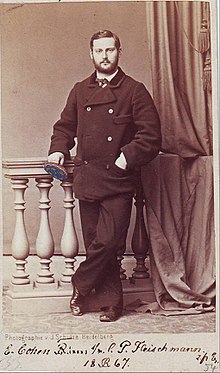Emil Cohen

Emil Wilhelm Cohen (born October 12, 1842 in Akjär near Horsens , Denmark, † April 13, 1905 in Greifswald ) was a German mineralogist and petrographer .
Life
From 1863 Cohen studied chemistry and physics in Berlin and Heidelberg. In 1873/74 he toured the gold and diamond fields of South Africa and published one of the first modern descriptions of the deposits. In 1878 he became professor of petrography at the University of Strasbourg and at the same time director of the geological survey of Alsace and Lorraine . Here he wrote his “collection of microphotographs to illustrate the microscopic structure of minerals and rocks” and thus became one of the founders of modern petrography.
In 1885 he became professor of mineralogy and geology at the University of Greifswald . Here he examined the Nordic debris and its origin. He also devoted himself to cosmic petrography , especially describing the structure of iron meteorites and the minerals they contain. For example, he isolated and analyzed an iron carbide that was later named cohenite after him .
From 1883 Cohen was a member of the German Academy of Sciences Leopoldina .
Fonts
- About the rocks of the southern Odenwald belonging to the Dyas. 1871
- Collection of photomicrographs to illustrate the microscopic structure of minerals and rocks. Stuttgart 1881.
- The upper Weilerthal and the initially adjacent mountains. Strasbourg 1889.
- Meteo Travel Studies.
- Meteorology. 1894-1905
- Summary of the results obtained from the investigation of the granular to dense meteors. Berlin 1900.
literature
- Walther Fischer: Cohen, Emil. In: New German Biography (NDB). Volume 3, Duncker & Humblot, Berlin 1957, ISBN 3-428-00184-2 , p. 310 ( digitized version ).
Individual evidence
- ^ Member entry of Emil Cohen at the German Academy of Natural Scientists Leopoldina , accessed on December 31, 2015.
| personal data | |
|---|---|
| SURNAME | Cohen, Emil |
| ALTERNATIVE NAMES | Cohen, Emil Wilhelm |
| BRIEF DESCRIPTION | German mineralogist and petrograph |
| DATE OF BIRTH | October 12, 1842 |
| PLACE OF BIRTH | Akjär near Horsens, Denmark |
| DATE OF DEATH | April 13, 1905 |
| Place of death | Greifswald |
